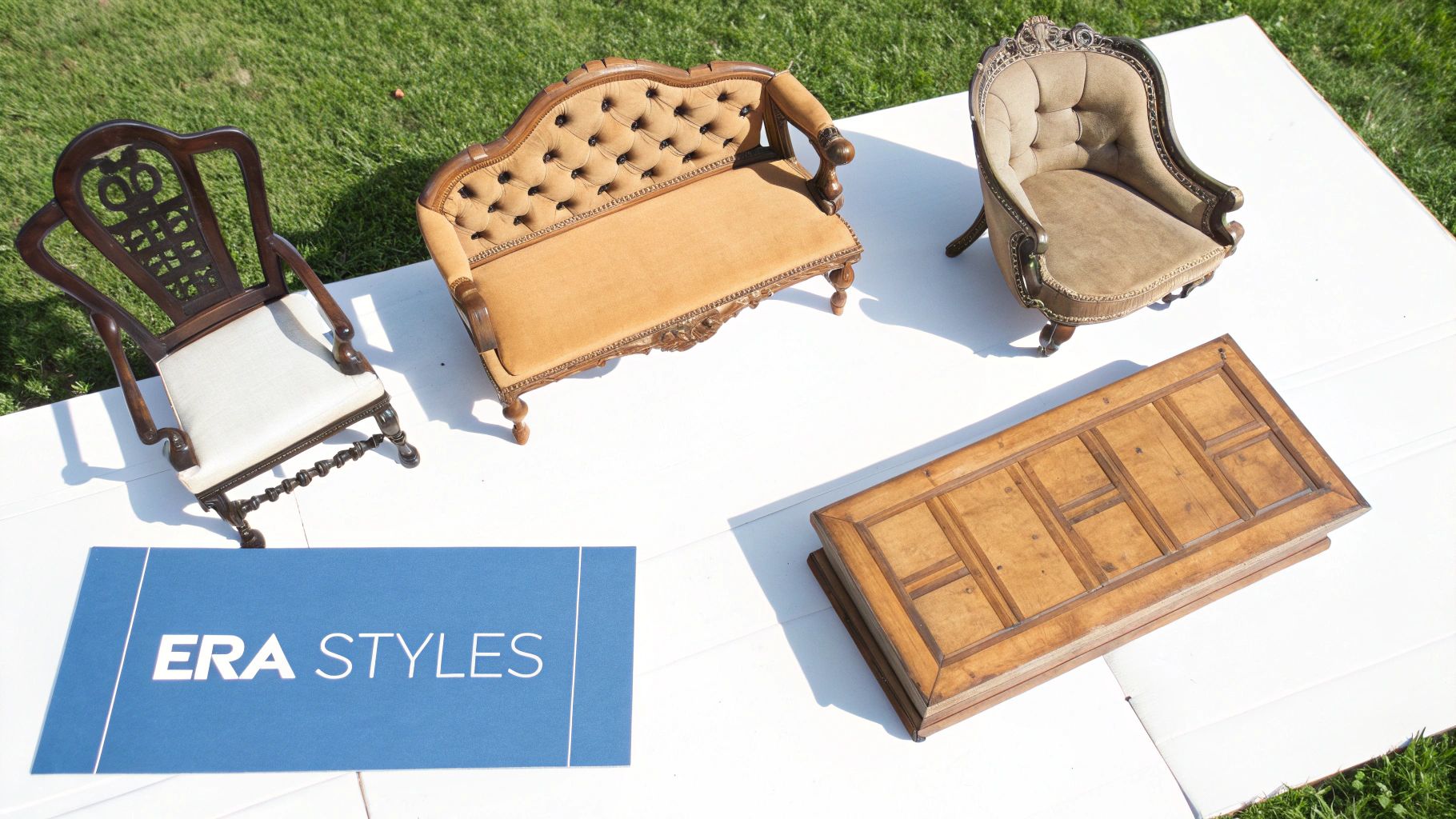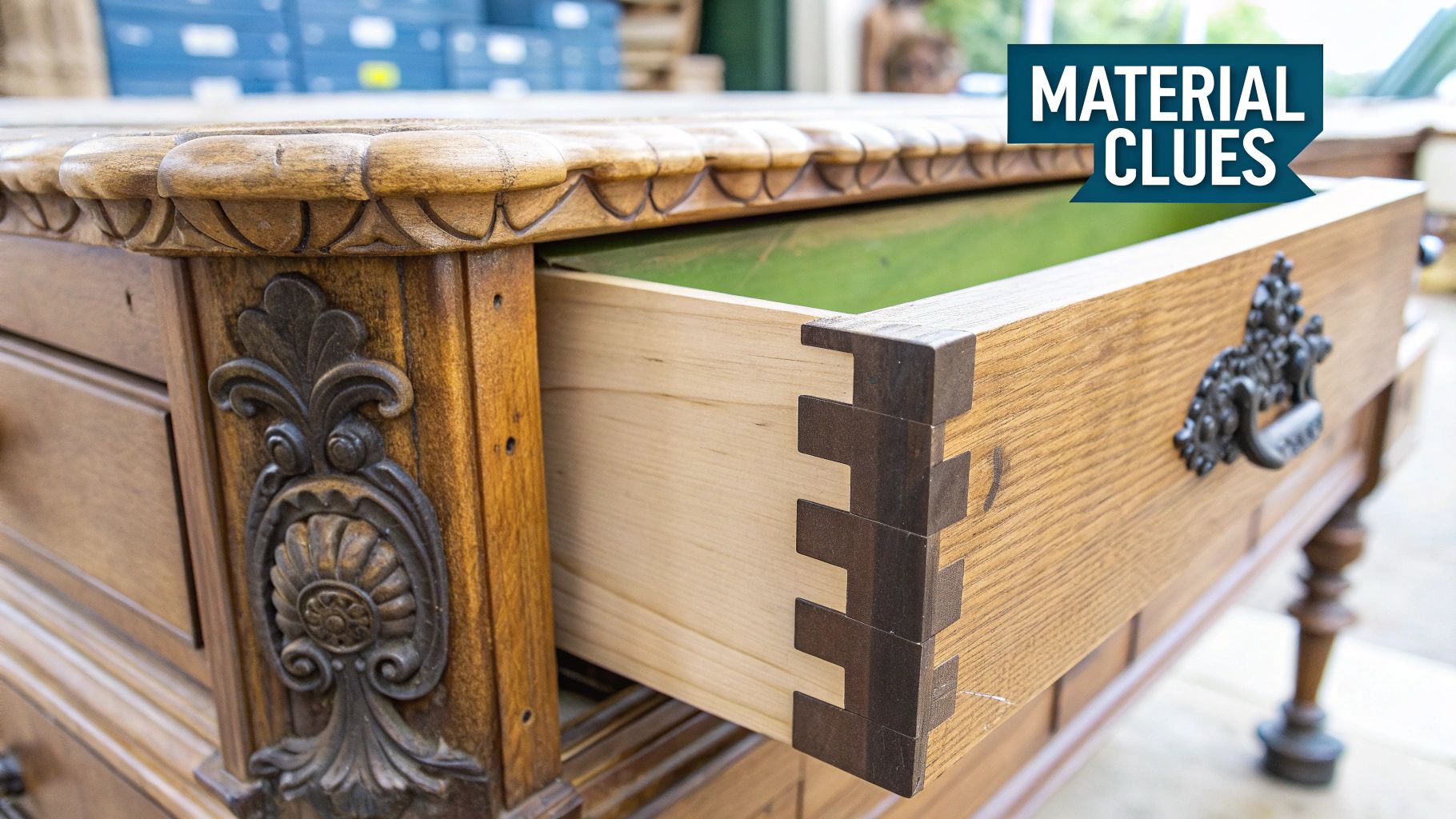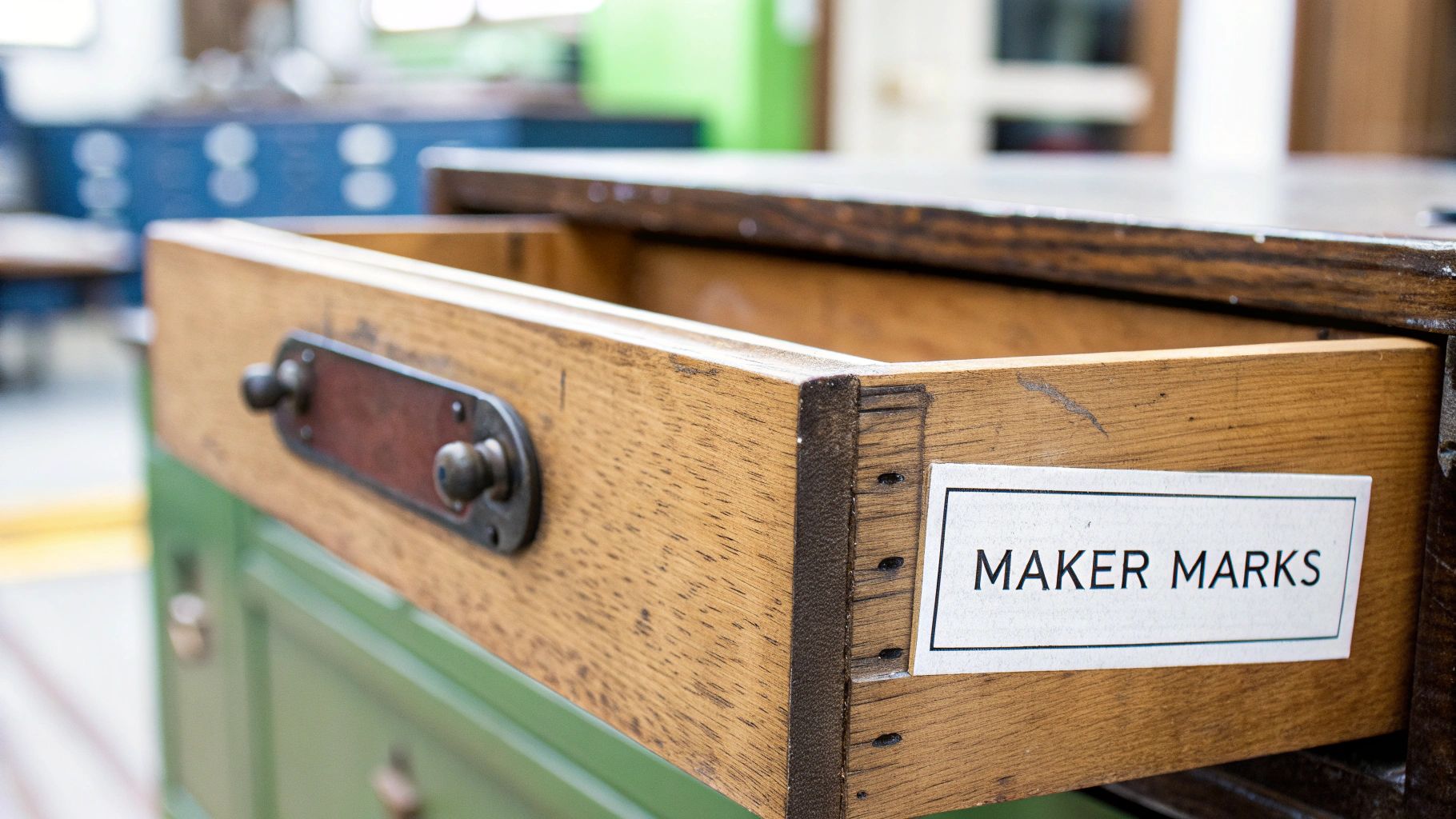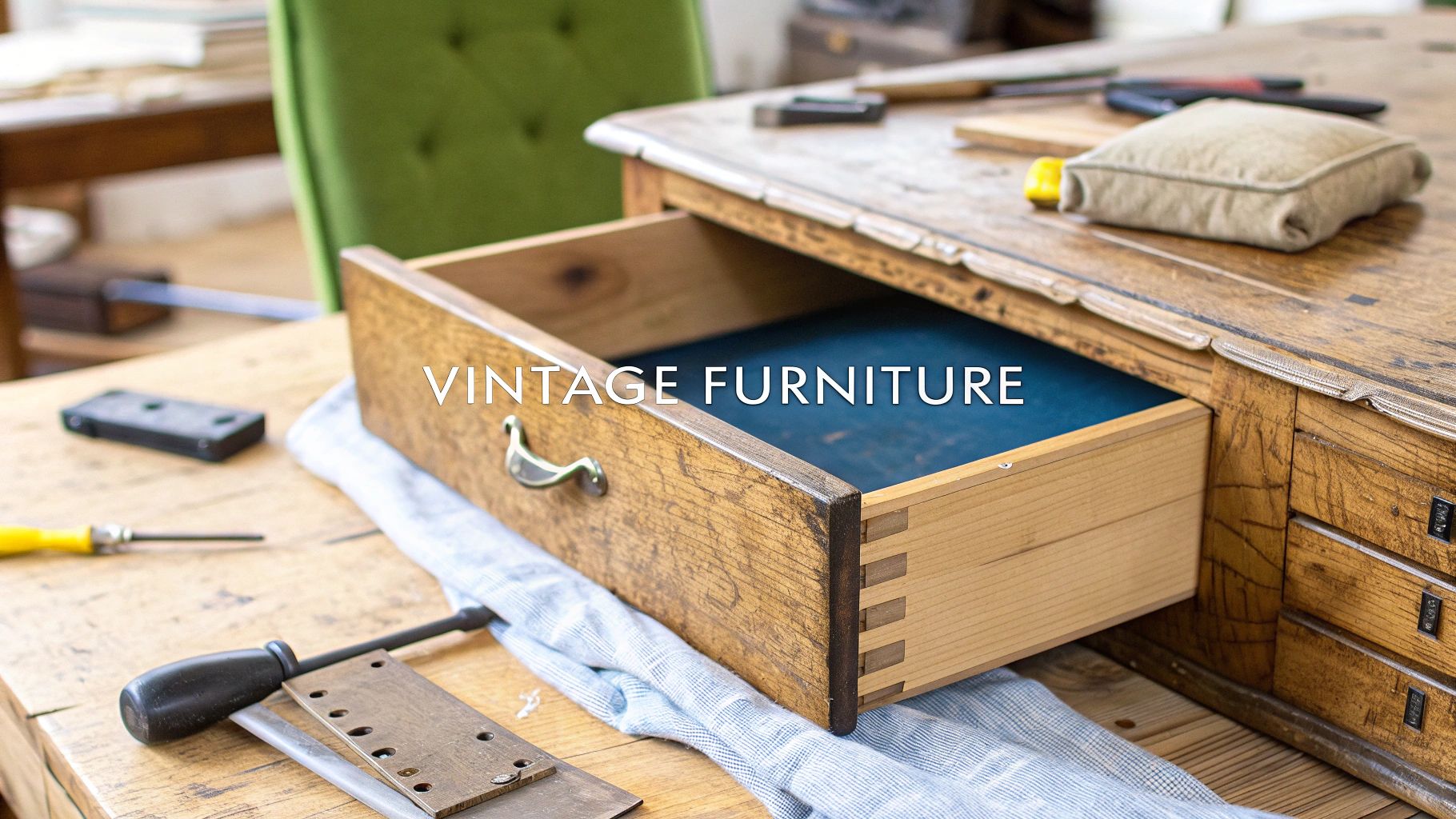When you're trying to figure out if a piece of furniture is truly vintage, you're looking for more than just its age. It's about becoming a detective. The real story is told through the piece's design style, how it was built, the materials used, and the signs of wear it has gathered over the years. Mastering this skill is what separates a truly valuable find from just another piece of old furniture.
What Separates Vintage from Just Old Furniture
Diving into the world of vintage furniture can feel like a lot at first, but it's an incredibly rewarding skill to develop. In a market that's constantly growing, being able to spot a genuine vintage treasure is more valuable than ever.
The global second-hand furniture market hit an estimated $34 billion in 2023, and it’s not slowing down. This boom is fueled by people wanting more sustainable options and unique pieces with character. You can see the data for yourself in market reports from firms like Grandview Research. For collectors, this growth means more hidden gems are out there, just waiting for someone with a trained eye to find them.
First things first, let's get the terminology straight. People often throw these words around interchangeably, but for collectors and designers, they have very specific meanings.
- Antique: To earn the "antique" title, an item must be at least 100 years old. These pieces are prized for their history, rarity, and the incredible craftsmanship of a long-gone era. If you’re interested in pieces from this period, our guide on how to identify antique furniture is a great place to start.
- Vintage: This is the sweet spot for items between 20 and 99 years old. A funky chair from the 1970s is vintage, but a table from 1915 is an antique. Vintage furniture almost always captures a specific, iconic design movement, like the clean lines of Mid-Century Modern or the glamour of Art Deco.
- Second-Hand/Used: This is simply a broad term for any pre-owned item that isn't old enough to be classified as vintage or antique.
To make this crystal clear, here’s a quick comparison:
Vintage vs. Antique: A Quick Comparison
This table breaks down the key differences between vintage, antique, and modern second-hand furniture. Use it as a quick reference when you're out hunting for your next piece.
| Characteristic | Vintage (20-99 Years Old) | Antique (100+ Years Old) |
|---|---|---|
| Primary Appeal | Nostalgia, specific design style | Historical significance, craftsmanship, rarity |
| Typical Styles | Mid-Century Modern, Art Deco, 70s Funk | Victorian, Queen Anne, Arts and Crafts |
| Construction | Mix of handmade & early mass production | Primarily handmade, hand-carved details |
| Common Materials | Plywood, plastics, chrome, teak | Solid woods (mahogany, oak), brass |
Understanding these distinctions is the first step toward making smarter buys and truly appreciating the items you find.
Why does this matter? Knowing the difference is fundamental. It keeps you from overpaying for something that's just "used" and helps you spot the genuine character and value in a real vintage or antique find.
Before you even get close enough to touch a piece, start training your eye. Do a quick scan and think like a seasoned pro. Does the overall shape scream 1950s? Does it look like it was carefully crafted by hand, or does it have the uniformity of something made in a factory? This first impression will set the stage for a more detailed inspection.
Reading the Clues in Construction and Joinery

The way a piece of furniture was put together tells you its life story. If you look at most modern, mass-produced furniture, you’ll find a lot of glue, staples, and particleboard. But genuine vintage and antique pieces were built differently, and learning to spot those techniques is key. The joints and hardware are like a fingerprint from a specific era.
Imagine you're at a flea market, standing between two similar-looking dressers. The first thing I always do is pull out a drawer. Look at how the drawer front is attached to the sides. This one simple move can tell you almost everything you need to know about its age and quality.
Hand-Cut vs. Machine-Cut Joinery
One of the most revealing details is the dovetail joint—that classic series of interlocking "pins" and "tails" that creates an incredibly strong connection. Before the late 19th century, these were painstakingly cut by hand.
- Hand-Cut Dovetails: Look for slight imperfections. The pins and tails won't be perfectly identical in size or spacing. You might even spot faint scribe lines where the craftsman marked their cuts. This beautiful lack of uniformity is the signature of pre-industrial, handmade quality.
- Machine-Cut Dovetails: These are the opposite—perfectly symmetrical, with uniform spacing and crisp, sharp angles. They started becoming common around the 1880s as furniture making moved into factories.
Finding those slightly wonky, uneven dovetails is a fantastic sign. It means you could be holding a piece with significant age, possibly a true antique. In stark contrast, many modern drawers are just stapled or glued, a dead giveaway of contemporary, lower-quality construction.
A Pro Tip: Don't just check one drawer. I make it a habit to inspect multiple drawers on the same piece. Seeing consistent, handmade joinery throughout strengthens the case that you've found a genuine vintage or antique gem.
It's Not Just About Dovetails
While dovetails are a classic indicator, other construction methods are just as important. The mortise-and-tenon joint, where a projecting piece (the "tenon") fits snugly into a hole (the "mortise"), has been a cornerstone of quality woodworking for centuries. Finding one tells you the piece was built to last.
And don't forget the hardware! Screws are a surprisingly accurate way to date furniture. Before the mid-1800s, screws were handmade and had a single slot that was often off-center. The perfectly uniform, cross-head Phillips screw wasn't widely used in furniture until the 1930s. If you find original, single-slot screws, especially ones that look a bit uneven, you're looking at a much older piece.
Think of it this way: a 1960s Danish teak credenza will likely have clean, machine-cut joints and single-slot screws, reflecting its mid-century origins. A modern knockoff, however, might use Phillips screws and have drawer fronts that are just nailed on. By examining these small but vital details, you stop guessing and start reading the furniture’s biography, written right into its own construction.
Investigating Wood, Upholstery, and Materials
 Once you've sized up the construction, the materials themselves tell the next part of the story. The specific wood, the texture of the fabric, even the surprising heft of a piece—these are all clues that speak to its age and origin. Learning to read them is a skill that turns a good eye into a great one.
Once you've sized up the construction, the materials themselves tell the next part of the story. The specific wood, the texture of the fabric, even the surprising heft of a piece—these are all clues that speak to its age and origin. Learning to read them is a skill that turns a good eye into a great one.
These skills are more valuable than ever. Vintage furniture is surging in popularity, not just for its unique style but also as a sustainable choice. With the global furniture market valued at a massive USD 768.36 billion in 2024, the demand for authentic retro pieces is booming. You can get a deeper look at these trends in this furniture market report.
Distinguishing Wood Types and Veneers
Different eras had their favorite woods. If you think of mid-century modern design, you probably picture the warm, rich grains of teak and walnut. Go back further, and you’ll find a lot more dark, heavy mahogany and oak.
But here’s where a lot of people get tripped up: solid wood versus veneer. A veneer isn't automatically a red flag for poor quality. In fact, many iconic mid-century designers used veneers to create beautiful, symmetrical "book-matched" patterns that you just can't get with solid wood planks.
The key is knowing what you're looking at.
- Check the Edges: Look at the edge of a tabletop or drawer front. On a veneered piece, the grain pattern won't continue seamlessly over the side. Instead, you'll likely see a thin line where the veneer stops and a different piece of wood (the edge banding) begins.
- Look for Repetition: On a large, flat surface like a credenza door, a perfectly repeating grain pattern is a dead giveaway for veneer.
- Feel the Weight: This one is simple but effective. Solid wood furniture is almost always much heavier than a piece made with veneer over a lighter core like particleboard.
Don't make the common mistake of writing off a piece just because it has a veneer. For many mid-century styles, veneer is the norm, not the exception. The real sign of quality is the core material. Plywood is a sturdy, durable choice, whereas particleboard can easily chip, warp, or crumble over time.
What Upholstery and Stuffing Reveal
If a piece is upholstered, the stuffing inside can be a fantastic time capsule. Before synthetics took over, furniture was filled with all sorts of natural fibers. If you can discreetly unzip a cushion or peek through a small tear, you can learn a lot.
Here’s a rough guide to what you might find stuffed inside:
| Material | Likely Era | Key Characteristics |
|---|---|---|
| Horsehair, Hay, or Cotton | Pre-1930s | Feels dense, coarse, and often lumpy. It's usually packed in very tightly. |
| Latex or Foam Rubber | 1940s-1960s | This is that early foam that gets incredibly brittle and crumbly as it ages. |
| Polyurethane Foam | 1960s-Present | The familiar spongy foam that yellows over time but holds up better than early rubber foams. |
Finding original horsehair is a strong clue you're looking at a true antique. On the other hand, finding that crumbly, dried-out foam almost screams mid-century. Understanding these materials is a huge part of the puzzle, and it’s a foundational skill as you learn how to value antiques and vintage treasures.
Finding and Decoding Maker's Marks
Think of a maker's mark as your furniture's birth certificate. It’s the single most direct clue you can get, often pointing you straight to the manufacturer, the collection, and sometimes even the exact year it was made. Finding one is the "aha!" moment every collector loves.

These signatures aren't always obvious. They can be anything from a faint ink stamp to a fancy metal tag, so you’ll need to put on your detective hat to find them.
Common Hiding Spots for Marks
Over the years, I've learned that while manufacturers weren't always consistent, they definitely had their favorite hiding spots. When I'm checking out a new piece, I have a mental checklist of where to look first.
- Inside Drawers: My first stop. I check the sides, back, and even the underside of every single drawer.
- The Back Panel: Gently run your hands over the back of a cabinet or dresser. Paper labels love to hide out here, often just out of sight.
- Underneath Everything: Flip it over if you can! The underside of tabletops, chair seats, and the bottom frame of a case piece are prime real estate for marks.
- Drawer Glides: Don't forget the runners. Sometimes, a company’s name is stamped right onto the wood or metal glides.
A good flashlight is your best friend here. Be prepared to get on your hands and knees. These marks were for internal tracking, not for us to find easily 70 years later!
Here's a hard-won piece of advice: If you find a paper label, do not try to clean it or peel it off, no matter how grungy it looks. A damaged original label is infinitely more valuable for identification than a clean spot where a label used to be.
Interpreting What You Find
Okay, you found something! Now the real fun begins. The mark itself tells a story. For instance, if you spot a ZIP code on a label, you have an instant clue. That piece can’t be any older than 1963, the year ZIP codes were introduced in the United States.
The type of mark also gives you hints about its age and quality.
- Ink Stamps: You see these all through the 20th century. If the stamp is faded or blurry, that’s a good sign of genuine age.
- Metal Tags: Small brass or aluminum plates were often used on higher-end furniture. It was a sign of quality.
- Wood Burnings (Brands): A really durable method. Iconic makers like Heywood-Wakefield are famous for their branded marks.
- Paper or Foil Labels: These are the most fragile, but they're often a goldmine of information, sometimes listing patent numbers or specific collection names.
Once you have a name or a logo, a quick search online can unlock the piece's history. This research process is a skill that applies to all sorts of collectibles, much like when you're mastering how to identify vintage glassware. By decoding these symbols, you’re turning a piece of "old furniture" into a documented artifact with a real story.
Look for a Story in the Finish and Natural Signs of Age
The surface of a piece of furniture tells its story. A genuine patina—that soft glow and subtle wear that only comes from decades of use—is almost impossible to fake. For me, it’s one of the most trustworthy signs of a truly vintage piece. It’s the history of an object written in tiny scratches, faded spots, and softened corners.

Before the mid-20th century, common finishes were shellac and lacquer. Shellac, which comes from bug resin, gives off a warm, amber glow but it's incredibly delicate. A quick test I've used for years involves finding a very hidden spot—say, the inside back of a leg—and dabbing a bit of denatured alcohol on it with a cotton swab. If the finish gets sticky or starts to dissolve, it’s almost certainly shellac. That's a strong clue you're looking at something old.
Modern finishes like polyurethane, on the other hand, are basically a plastic coating. They're built to resist alcohol and water, and when they fail, they tend to chip or peel off in a sheet rather than wearing down gracefully. An original, time-worn finish feels different; it feels like it's part of the wood, not just sitting on top.
Read the Wear and Tear
Authentic aging is beautifully inconsistent. It follows logical patterns of human use. Just think about where a piece would naturally get the most contact over fifty, sixty, or a hundred years.
Here’s what I look for:
- Softened Edges: Corners and edges on a piece that's been around for a while will be slightly rounded and smooth from countless bumps and touches. Artificially distressed furniture often has randomly sanded edges that look and feel rough, not naturally worn down.
- Sun Fading: Check for subtle, uneven discoloration. The side of a cabinet that sat by a sunny window for decades is going to be lighter than the other side. This is something that's very difficult to replicate convincingly.
- Leg and Feet Wear: The very bottoms of the feet should show the most punishment. You want to see scuffs, little dents, and maybe some darkening from years of mopping and just existing on a floor. A perfect set of feet on a supposedly old table is a huge red flag for me.
A classic example is the area around original drawer pulls. Over time, fingernails, rings, and the oils from hands create a distinct little halo of wear right around the hardware. This tiny detail is a hallmark of authenticity that you just won't find on a new piece or one that's been hastily refinished.
One of the biggest mistakes I see people make is confusing authentic patina with artificial distressing. Artificially "aged" furniture has repetitive, uniform marks. Genuine wear is random, logical, and tells the story of the piece's life.
Identifying the Original Finish
Figuring out the finish helps you date a piece and understand its journey. An original finish, even with its flaws, is almost always more desirable to collectors than a flawless, modern refinishing job.
| Finish Type | Telltale Signs of Age | Common Era |
|---|---|---|
| Shellac | Dissolves with alcohol; shows fine "alligatoring" or crazing; susceptible to water rings. | Pre-1930s |
| Lacquer | Can yellow over time; wears thinly at edges; may show fine hairline cracks. | 1920s-1960s |
| Polyurethane | Very durable; chips or peels like plastic; has a distinct, often thick, surface feel. | Post-1960s |
By carefully examining the finish, you're looking past the basic style and construction to read the piece's biography. These subtle signs of age are the beautiful imperfections that confirm you’ve found a true vintage treasure, not just a modern imitation.
Let's Put This Into Practice: A Real-World Example
All the theory in the world is great, but real confidence comes from getting your hands dirty. Let’s walk through a scenario you’ll likely encounter.
Picture this: you're wandering through a flea market and a low, sleek dresser catches your eye. It has those classic clean lines and tapered legs that just scream mid-century modern. So, where do you start?
Your first move should always be to pull out a drawer. Look at the joints. In this case, you see machine-cut dovetails, perfectly uniform and precise. That’s your first major clue. It tells you this piece was factory-made, likely sometime in the 20th century, and not an 18th-century, hand-sawn antique. You also notice the drawer box is solid wood, not particleboard—a great sign of quality craftsmanship from the era.
Next, you get a feel for the materials. The top and sides show off a gorgeous, consistent grain. But a quick peek at the edge reveals a very thin, distinct line. Ah, it’s a rich walnut veneer over a plywood core. This isn't a flaw; it's actually a hallmark of many mid-century pieces, designed for both beauty and stability.
Finding the Final Pieces of the Puzzle
Now, it’s time for a little treasure hunting. You run your hand along the back panel, but it’s smooth and unmarked. Don't give up. You open the top left drawer, and there it is—a faint ink stamp inside. It's a bit smudged, but you can just make out the name "Bassett" and a location in Virginia.
A quick search on your phone confirms that Bassett Furniture was a massive American producer of mid-century furniture. You've just found your maker.
The last step is to look closely at the finish. It’s a thin, aged lacquer, not the thick, glossy polyurethane you'd find on a modern reproduction. You can see some subtle fading on one side, probably from spending years next to a sunny window. There’s also some gentle wear around the original brass pulls from decades of use. These aren't defects; they’re the authentic story of the piece’s life.
By layering all these clues—the machine-cut dovetails, the walnut veneer, the Bassett stamp, and the aged lacquer finish—you can confidently say you’ve found a genuine American mid-century modern dresser, likely from the 1960s.
This kind of hands-on detective work is what turns you from a casual browser into a savvy collector. It’s this growing passion for unique design and sustainable living that's behind the explosive growth of the second-hand market.
In fact, the market is predicted to surge to USD 74.19 billion by 2033, a huge leap from USD 36.5 billion in 2024. If you're interested in the numbers behind this eco-conscious trend, you can dig into the data in this market research from Renub Research.
Your Top Vintage Furniture Questions Answered
When you're starting out, the world of vintage furniture can feel a little overwhelming. You're standing in a flea market, staring at a cool-looking chair, and a dozen questions pop into your head. That's a good thing! Let's clear up a few of the most common ones I hear all the time.
Is It Vintage or Antique?
This is the big one, and the answer is surprisingly simple: it all comes down to age.
Think of antique as the century club. An item has to be at least 100 years old to earn that title. A dresser built in 1920 is now officially an antique. These pieces are often prized for their history, craftsmanship from a bygone era, and sheer rarity.
Vintage is a bit younger. The general rule is that an item is vintage if it's between 20 and 99 years old. That groovy 1970s armchair? Vintage. Your grandma's solid oak table from the 1950s? Also vintage. Anything younger than 20 years old is typically just called "used" or "second-hand."
Will Refinishing Ruin Its Value?
Ah, the great refinishing debate. This isn't a simple yes or no; it really depends on the piece itself.
If you’re lucky enough to have a truly rare, historically significant antique, then leaving the original finish intact is almost always the right call. The patina and wear are part of its story and value. Refinishing a piece like that could slash its value dramatically.
However, for more common vintage furniture—say, a mass-produced mid-century modern credenza—a tasteful, professional refinish can actually make it more desirable, especially if the original finish was in rough shape. The key word here is professional. A sloppy DIY sanding and staining job can make things much, much worse.
My advice? Always aim to preserve the original finish if you can. If a piece is so damaged that it needs a refresh, invest in getting it done right by someone who respects the furniture's original character.
Where Are the Best Places to Find Vintage Furniture?
The thrill of the hunt is half the fun, and great finds can pop up anywhere!
Your local spots are often goldmines. Start with:
- Thrift stores
- Consignment shops
- Flea markets
- Garage and estate sales
Estate sales are particularly fantastic because you get to see pieces in their original home, which often gives you a better sense of their history. Don't forget online marketplaces like Facebook Marketplace or Etsy, but be a savvy digital shopper. Always insist on seeing tons of pictures—close-ups of joints, any labels or marks, and every little bit of damage—before you commit to buying.
Ready to stop guessing and start knowing? With Curio, you can identify furniture, antiques, and collectibles just by snapping a photo. Turn your curiosity into real expertise and discover the stories hidden in your finds. Download Curio today and let your treasures talk at https://www.curio.app.
